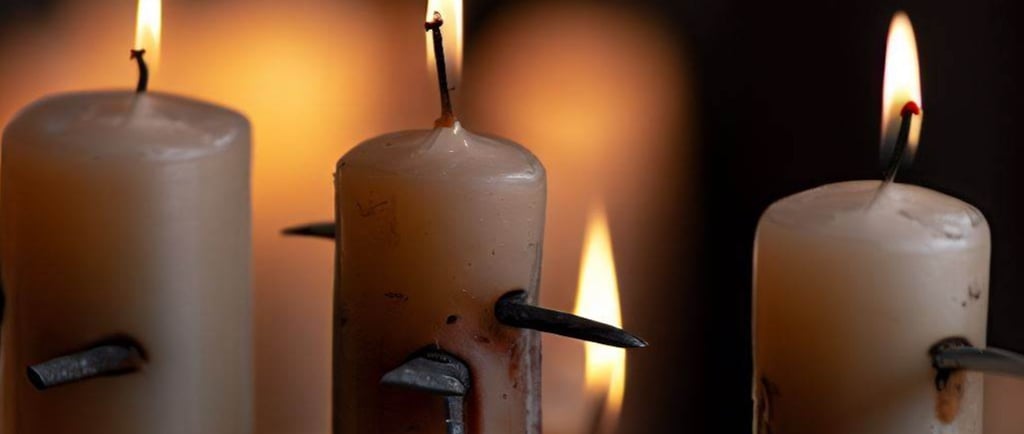The Candle Clock 🕯️ Medieval Timekeeping
Stories About Time: Measuring Moments Through History ⏳🌞🌕 from the chapter "Towards an Understanding of Linear Time" from the History Album. In this chapter we invite children to a journey through the fascinating evolution of timekeeping. Starting with observing the Sun🌞, and people who first noticed the movement of shadows to mark the day, to the people who noticed the phrases of the Moon 🌙, and tracked the lunar cycle to create months, these stories uncover humanity’s inventive ways of measuring moments.Children will marvel at ancient innovations, like sundials and lunar calendars, and explore cultural contributions, such as candle clocks 🕯️ and water clocks 🌊, that paved the way for modern timekeeping. Each story weaves history, science, and culture, showing how humans connected with the natural world to organize their lives. 🌿✨Through these narratives, children will see time not just as a number on a clock, or passing month on the callendar, but as a rich legacy of human curiosity and creativity. With hands-on activities like building sundials and journaling moon phases, they’ll become modern-day timekeepers, inspired to ask, “How did people measure time before clocks?” and “What can I discover about time?”This vivid exploration links the past to the present, sparking imagination and a deeper appreciation for the ingenuity of those who came before us. 🌍✨
HISTORY STORIES
12/12/20243 min read


Do you remember how the Tower of the Winds 🏛️ combined water and shadows to track time? People had already been using candles for light and warmth 🕯️, and one day, they realized these glowing companions could also tell time.
Fire had always been essential—it kept us warm 🔥, helped us cook 🍳, and gave us light 🕯️. And so over 1,040 years ago, ,around 980 AD, people began using candle clocks to measure time during the darkest hours of night. 👏 Can – dle Clock 👏!
Imagine a tall candle standing in a holder, with marks carved or painted along its length. Each mark represented a certain amount of time—perhaps an hour or half an hour. As the candle burned, the flame slowly moved downwards, passing each mark and showing the time that had passed.
But the Romans added something even more ingenious! They inserted metal nails or pins at specific points along the candle 🕯️. As the flame melted the wax and reached one of these pins, the heat would loosen it, and the pin would drop into a metal tray below with a little clink! 🛎️ This simple yet brilliant feature turned the candle clock into an alarm clock, perfect for letting people know when time was up. Imagine waking up in ancient Rome to the gentle sound of a pin dropping into a tray, signaling the start of a new day! 🌞
Candle clocks were used in castles 🏰, monasteries 🛡️, and homes 🏡.One of the most famous users of the candle clock was Alfred the Great, a Saxon king of England 🏰. He came up with a fun and ingenious method! He used six marked candles 🕯️, each designed to burn for exactly four hours. Together, they measured a full 24-hour day. Imagine Alfred waking up in his castle, starting his day by lighting the first candle:
“This one’s for morning prayers and breakfast.” 🙏🍞
Then there was the candle for meetings:
“This one will make sure I don’t let the advisors talk too long!” 🛡️🗣️
And, of course, a candle for the bathroom:
“I’ll light this one when I need some peace and quiet!” 🛁✨
The candle clock was brilliant for marking time indoors, but it had its limits. In ancient China, the emperor dreamed of a clock unlike any the world had ever seen—a clock that didn’t just measure the hours but also revealed the secrets of the stars and planets 🌟. And so he ordered this dream to become a reality. How does a clock can measure time and the movement of the stars at the same time? Who made it?
Well, that’s a story for another day… 🌌✨
💡 Follow-Up Activity: Make Your Own Candle Clock 🕯️✨
Do you want to create your own candle clock, just like in the old days? Here’s what you can do:
Visit a Shop 🛒: Ask a chaperone to walk with you to a nearby shop so you can buy two equal candles. Look for tall, straight candles that will burn steadily.
Test the Burn Time 🔥: Light one candle and let it burn for an hour (set one hour timer to remind you). Keep track of the time and notice how much the candle melts in an hour.
Mark the Divisions ✍️: Once you know how far the candle burns in an hour, use a marker or a small pin to make divisions along the length of the second candle. Each division will represent one hour of time!
Plan Your Hour ⏳: Light your marked candle and challenge yourself! Plan an activity—maybe you math, geography, art, history or project work or even cleaning up the shelves. See how much you can accomplish before the candle burns down to the next mark.
Observe and Discuss 💬: Was an hour enough time for what you planned? What else could you use your candle clock for?
This story is part of the following Clock Stories Series which can be turned into Drama Play or Storybook Compilation.
Ancient Timekeeping
🌞 The Sun Watchers ~3500 BCE
🌊 The Water Clock Wonders ~1500 BCE
🏛️ The Tower of the Winds ~50 BCE
Medieval Timekeeping
🕯️ The Candle Clock ~980 CE
🌌 Su Sung’s Astronomical Water Clock ~1092 CE
⏳ The Hourglass Sand Masters ~14th Century
🛎️ The Mechanical Church Bells Chime ~14th Century
Science in Timekeeping
🌟 Astronomical Marvel: The Prague Clock ~1410 CE
🌍 Galileo’s Pendulum Discovery ~1602 CE
🕰️ Pendulum Perfection ~1656 CE
Modern Timekeeping
🌊 Marine Chronometer ~18th Century
⏱️ The Quartz Revolution ~1920s CE
With Montessori joy,
Vanina 😊

